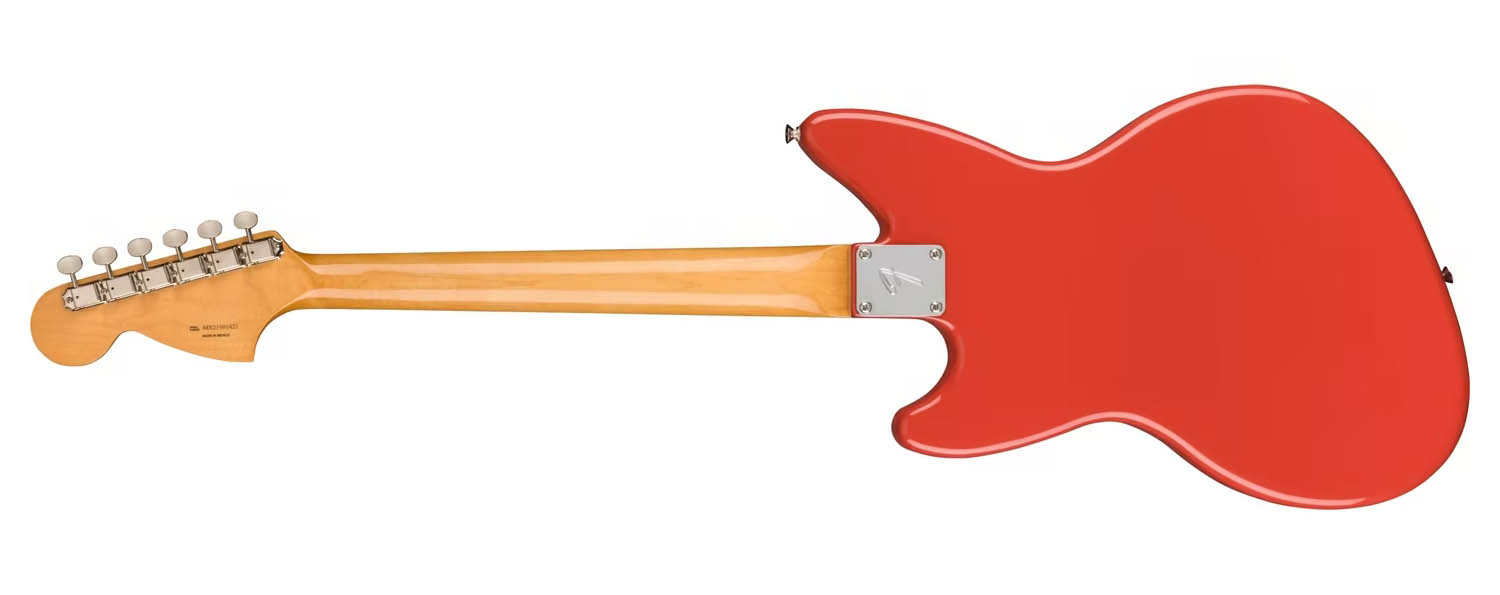Guitar World Verdict
Reissued for the 30th anniversary of Nevermind, the Kurt Cobain Jag-Stang is ideal for Nirvana fans or anyone who wants to explore their own brand of subversive sounds.
Pros
- +
Impressive variety of tones.
- +
Well-balanced and playable.
- +
Shorter scale length allows for heavier gauge strings without string bending fatigue.
Cons
- -
Short scale won't suit everyone.
You can trust Guitar World
Sometime in 1993, Fender approached Kurt Cobain about collaborating on the design of a signature guitar. Cobain was amused but also flattered by the proposal, and he quickly conceived and sketched a new design that combined features of his favorite guitars: a modified 1965 Fender Jaguar and a 1969 Fender Competition Mustang.
The Nirvana guitarist called his creation the Jag-Stang. Fender delivered the first Jag-Stang prototype to Cobain in early 1994, and the guitarist used it for a handful of shows that year before he took his own life on April 5, 1994.
Fender produced the Jag-Stang from 1995 through 2005 when it was discontinued, but Fender recently revived the model in commemoration of the 30th anniversary of the release of Nirvana’s breakthrough Nevermind album. The new version differs just slightly from the original run, but it still offers players seeking Cobain’s iconoclastic brand of musical rebellion a tonal palette that stands apart from the crowd.
Features

The most distinctive feature of the Kurt Cobain Jag-Stang is its elongated compact offset body shape, based on a Mustang’s upper bout combined with a Jaguar’s lower bout. While the original production model had a basswood body, this version’s body is made of heftier alder (like a vintage Jaguar and some '60s Mustangs). Like the original Jag-Stang, the body has no belly or arm rest contours, and it is available with either a Sonic Blue or Fiesta Red finish.

The Jag-Stang’s neck is constructed of maple with a rosewood fingerboard. Neck features include a 24-inch Mustang scale length, 22 vintage thin profile frets, 7.25-inch radius, slim C-shape profile and 1.575-inch nut width (slightly wider than the original Jag-Stang’s nut).
The pickups are a custom Jag-Stang bridge humbucker (7.18k ohm resistance) and custom Jag-Stang neck single-coil (5.73k ohm resistance), which each are wired to separate three-position slider switches with on, off and phase settings as well as master volume and master tone controls.
Hardware consists of a Mustang rocker bridge with six barrel saddles, Mustang “dynamic vibrato” tailpiece, vintage-style tuners, Jazz Bass-style knobs and four-ply aged white pearloid pickguard.

Performance
Although the Jag-Stang has a somewhat compact body like a Mustang as well as a shorter 24-inch scale length, our example was heavier than we expected thanks to its alder body construction.
Played in a standing position, the body feels impressively well balanced thanks to the extended lower treble bout, which also contributes to the model’s tonal punch and depth by providing additional body mass below the bridge. The large CBS-era-style headstock also enhances the model’s tonal range, resulting in surprisingly big sound for a relatively small guitar.
The 24-inch scale results in a slinky feel that makes it easy to perform dramatic string bends. The Jag-Stang ships with .010-.046 gauge strings, but players could use heavier .011 or .012 sets without experiencing uncomfortable string tension. The slim C neck is exceptionally comfortable as well.
One request that Cobain made after receiving the prototype was having belly and armrest contours added, and I wish the Jag-Stang featured that for added comfort.
Although the individual slider switches for each pickup don’t facilitate ultra-quick tonal switching during performance, they do offer a wide range of cool and unusual tones. To me, the humbucking bridge/single-coil neck configuration is highly underrated, and here the switches allow users to take advantage of this setup’s versatility.
The humbucker has a vivid growl that pairs well with a high-gain amp, delivering snappy percussive attack and bristling definition with an aggressive midrange wallop. The neck pickup sounds round and punchy, but it also shines on clean settings where it delivers great tones for funk and blues. The out-of-phase settings have a snotty, nasal personality that’s distinctive and oddly alluring.
Specs
- PRICE: $1,249 / £1,199 street (inc deluxe gigbag)
- ORIGIN: Mexico
- TYPE: Double-cutaway solidbody electric
- BODY: Alder
- NECK: Maple, Slime ‘C’ profile, bolt-on
- SCALE LENGTH: 609.6 mm (24”)
- NUT WIDTH: 1.575" (40 mm)
- FINGERBOARD: Rosewood, black dot markers, 7.25” radius
- FRETS: 22, vintage
- HARDWARE: 6-Saddle Vintage-Style Mustang Tremolo, nickel/chrome
- ELECTRICS: Jag-Stang Humbucking pickup (bridge), Jag-Stang single-coil (neck) with volume, tone, and two 3-Position Pickup On/Off-In/Out Phase slide switches
- LEFT-HANDERS: Yes
- FINISHES: Fiesta Red, Sonic Blue
- CONTACT: Fender
Chris is the co-author of Eruption - Conversations with Eddie Van Halen. He is a 40-year music industry veteran who started at Boardwalk Entertainment (Joan Jett, Night Ranger) and Roland US before becoming a guitar journalist in 1991. He has interviewed more than 600 artists, written more than 1,400 product reviews and contributed to Jeff Beck’s Beck 01: Hot Rods and Rock & Roll and Eric Clapton’s Six String Stories.
“This would make for the perfect first guitar for any style of player whether they’re trying to imitate John Mayer or John Petrucci”: Mooer MSC10 Pro review
“The most in-demand mods straight from the factory”: Fender’s elevated Player II Modified line brings the firm’s most sought-after guitar upgrades to the masses













